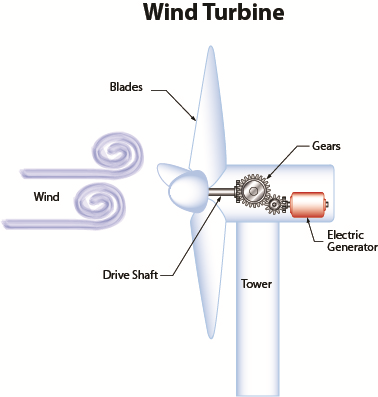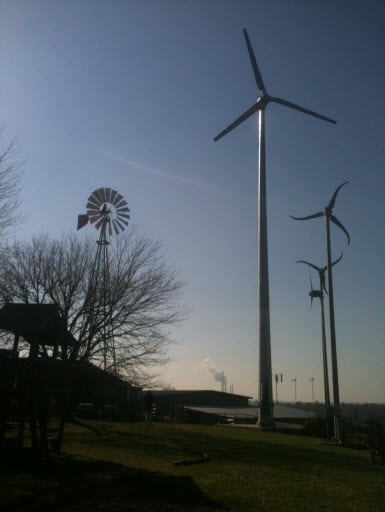What It Is and How It Works–the Basics
Small wind turbines utilize moving air caused by differences in air pressure in our Earth’s atmosphere to provide clean renewable energy.
A wind turbine consists of the following key components:
- Blades connected to a central hub; together these are called the rotor.
- A shaft, a horizontal rod connected to the rotor which turns with the rotor.
- A gear box on the end of the shaft which turns with the shaft and connects to a generator.
- A generator that produces electricity.
- A tower or steel lattice that holds up the wind turbine.
More information on how wind turbines operate is available at the U.S. Department of Energy’s How Do Wind Turbines Work? webpage.

Illustration by Chip Gribben
Costs of a Small Wind Turbine
Understanding the Incentives
The information below on incentives is current as of February 2013. There are no local incentives available at this time. For the most up to date information on incentives, visit www.DSIREUSA.org.
- Incentives are available from the federal government for small wind turbines, including 30% of the project expense for projects up to 100 kW. Learn more.
- Incentives are also available from the State of Maryland for wind turbines via the Windswept Grant program, including up to 50% of net installation costs after federal and any local incentives. The maximum amount of grant money is $100,000.
Net metering: With grid-tied systems, wind energy customers can be compensated for energy they produce that goes to the grid under Maryland’s net-metering law.
Pro Formas – Costs and Payback
The information below compares four wind turbine systems and shows the impact of incentives and tax credits as well as estimated net cash outlays.
|
Pro-formas* |
5kW (60’tower) |
6kW (47’tower) |
10kW (80’tower) |
20 kW |
|
Estimated Output (12 mpg average) |
950 kW/hr/mo |
743 kW/hr/mo |
1,900 kW/hr/mo |
3,8 00 kW/hr/mo |
|
Price (turnkey) |
|
|
|
|
|
Federal Tax Credit |
|
|
|
|
|
MD State Grant |
|
|
|
|
|
Final Cost in MD |
$41,580 |
|
|
|
|
20 year estimated fixed cost per kW/hr |
18.2 cents/kW/hr |
11.5 cents/kW/hr |
10.2 cents/kW/hr |
9.3 cents/kW/hr |
*For illustrative purposes only. A Pro-forma is assumed, forecasted, or informal information. It gives an idea of how the actual finances may look if underlying assumptions hold true. Actual costs and incentives depend upon site conditions and programs that are applicable to your situation. These pro-formas are not guaranteed and are subject to change without notice. Check www.dsireusa.org for the latest information on incentives. Pro-formas provided by Potomac Wind Energy.
The length of the payback period for a wind turbine is dependent upon the quality of the turbine, electricity rates, wind at the installation site, maintenance and insurance costs, financing options, and incentives. The time is takes to fully recover your costs can range from 2 to 20 years depending on these and other factors.
To get a rough idea of the payback period, determine the amount you pay on electricity bills each year before you plan to install your system. Take the cost of your turbine after incentives and add additional predictable costs such as insurance, maintenance, and financing costs. If your wind turbine will offset all your electricity, you can divide your estimate of the total cost by the annual bill and determine approximately how many years it will take to pay it off. If your wind turbine will only be offsetting part of your use, you will need to adjust the calculation accordingly.
Paying for a Wind Turbine
A wind turbine is a major investment. After incentives and tax credits are applied, costs may range from $20,000 to more than $80,000. Your return on investment (ROI) will depend on the size of turbine, height of the tower, average wind speed specific to your location and the current and projected price per kilowatt/hour charged by your utility.
Grant and tax credit money may cover 40-60% of the total cost of a system, however in some cases it may take up to a year to get that money.
Third party loan programs are available through some turbine manufacturers. Home equity and lines of credit are available from your lending institution.
Deciding if the System is Right for You
Proper siting of a small wind turbine is the most important factor. Households seriously considering installing a small wind turbine should consult Southwest Windpower’s excellent and concise Consumer Guide: Wind Turbine Siting. The U.S. Department of Energy’s Small Wind Electric Systems – A U.S. Consumer’s Guide is another good resource.
Before deciding if a small wind turbine is the right system for you, consider the following questions:
1. What are the recommended criteria for a wind turbine?
They include: (1) a clear, smooth, and exposed location, (2) good western wind exposure, (3) an accessible site, and (4) ability to tie into electric grid (battery storage is an option).
2. What is the average wind speed for your specific site? This is the most important factor!
The US Department of Energy (DOE) recommends wind speeds from 9.8 up to 15 miles per hour are required for a small wind turbine and to acquire a sufficient amount of electricity to make the investment cost-effective. More information is available at DOE’s National Renewable Energy Laboratories’ Wind Resource Assessment webpage. The State of Maryland’s Anemometer Loan Program loans wind measuring devices to property owners allowing them to quantify wind resources on their property.
3. Will installing a wind turbine comply with Frederick County’s zoning ordinance or other local restrictions or ordinances?
One important criterion is that wind turbines should be sited on a minimum of one acre of land. Be sure to check Frederick County’s Wind Energy Systems ordinance to make sure the windmill dimensions fulfill the requirements. If you are in a municipality, be sure to check their ordinances as well.
4. Will your neighbors be concerned about your wind turbine installation?
If you live in a neighborhood, it would be advisable to consult your neighbors regarding your interest in building a wind turbine first. It will minimize opposition if they understand how it will impact them. Urban or densely developed neighborhoods are not suitable for small wind turbines. Better renewable energy options for urban environments may be solar PV or thermal systems.
5. How much electricity can be produced?
This varies depending on the wind speed and system size. The DOE’s Small Wind Electric Systems: A U.S. Consumer’s Guide estimates that a 1.5 kilowatt system (costing about $7,000) can produce 300 kilowatt hours of electricity a month with a 14 mph wind speed on average. The power of wind is exponential so the same 1.5 kilowatt system will only produce about 37 kW/hr per month at a 7 mph average wind speed.
6. Will the amount of electricity produced be worth the investment needed to install and maintain a wind turbine?
Examining installation and maintenance costs should be part of the decision making process. Another expense to factor in is the cost of the base for the wind turbine.
7. What about roof-mounted micro-wind turbines?
These turbines are intended for dense urban areas. There are several things to consider before making the financial commitment. The cost to purchase and install micro-wind turbines may be excessive compared to the amount of electricity generated. They may produce noticeable noise in the house. In addition, most roofs may not be structurally sound enough to support a wind turbine that can generate a lot of vibration.
A small wind turbine makes the most sense if you can answer yes to the following questions:
- Do you live on one or more acres of land?
- Do you plan to keep this property for 10 or more years?
- Are you comfortable making a financial investment of over $20,000, or willing to apply for a loan or other financing?
- Do you have consistent wind speeds from 9.8 up to 15 miles per hour on your property?
- Can the wind turbine be easily connected to electric meters and the grid?
Local Installation: Requirements and Expectations
Frederick County has a wind ordinance (Ordinance Number 09-11-515). The ordinance has a size and height restriction for residential wind turbines. A few key points in the wind ordinance follow; read the full ordinance for more details.
- The ordinance applies to wind turbines with a height of 10 ft. or more.
- Power produced must be used to run the property; owners cannot sell electricity produced.
- The structure must be a certain distance away from the following (as determined by the height of the tower + the length of the blade + 20 ft.):
- County right of way (as referenced on the comprehensive plan),
- Entrance or exit from the property,
- Above ground power lines, and
- All property boundaries.
- Tip of the lower blade needs to be at least 30 ft. above obstruction.
- The structure cannot be placed in the required front yard setback.
- Putting lights on the wind turbine is not allowed unless required by the Federal Aviation Administration (FAA).
- The blade tip or vane of the wind turbine must have a clearance of no less than 15 ft. with the reference point — being the lowest point of the blade arcs.
- There can be no more than two wind turbines per property.
Typical small wind turbines are purchased as a ‘Turn Key’ Installation. The dealer/ installer secures the appropriate permits, inspections, and subcontractors and assist the customer in filling applications for Maryland Energy Administration ‘Wind Swept ’Grant and for Net Metering from the utility power company.

Assorted small wind turbines at Potomac Wind Energy in Dickerson, MD
Contributors: Laurie Wilmot, Intern; Dr. Carlos Fernandez-Bueno, Potomac Wind Energy